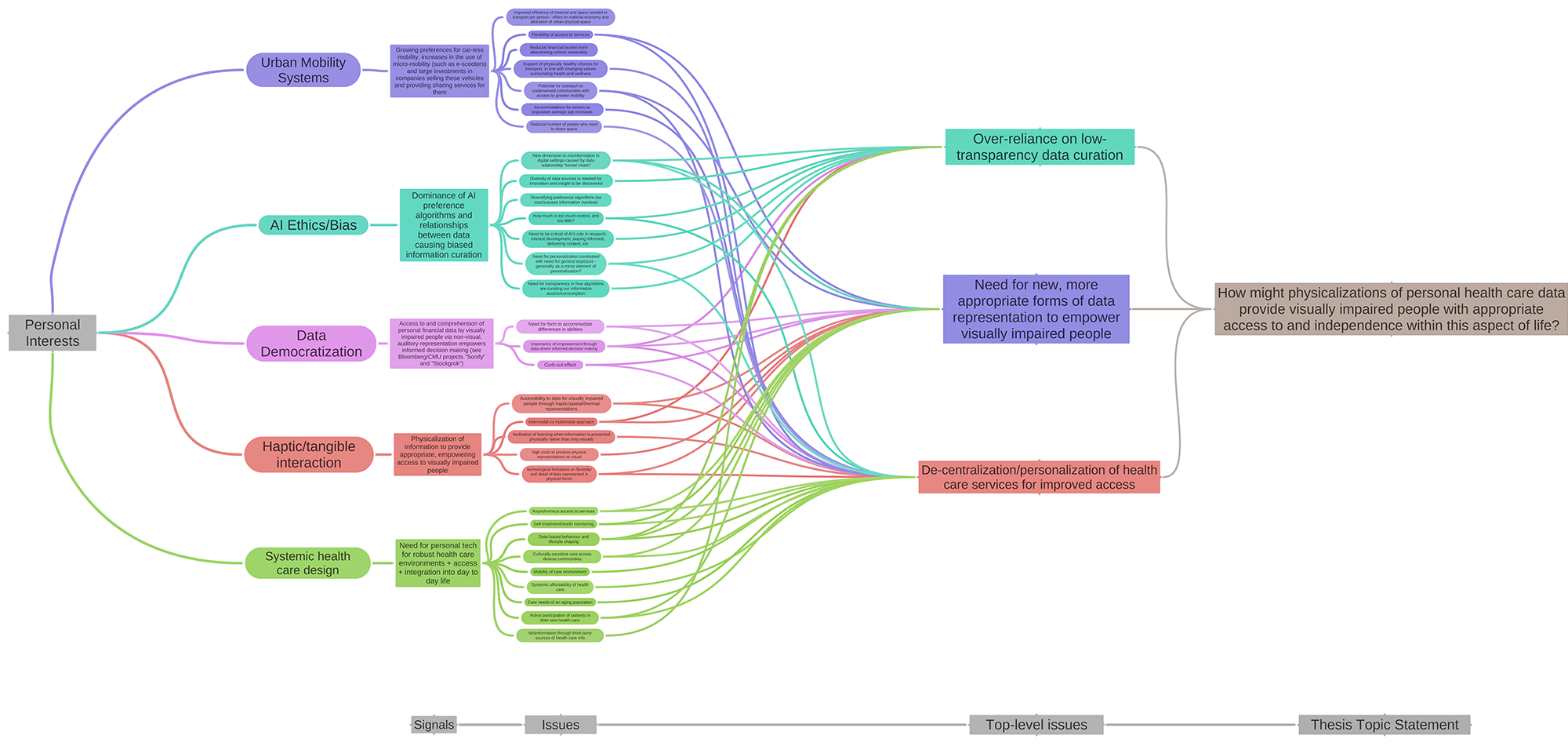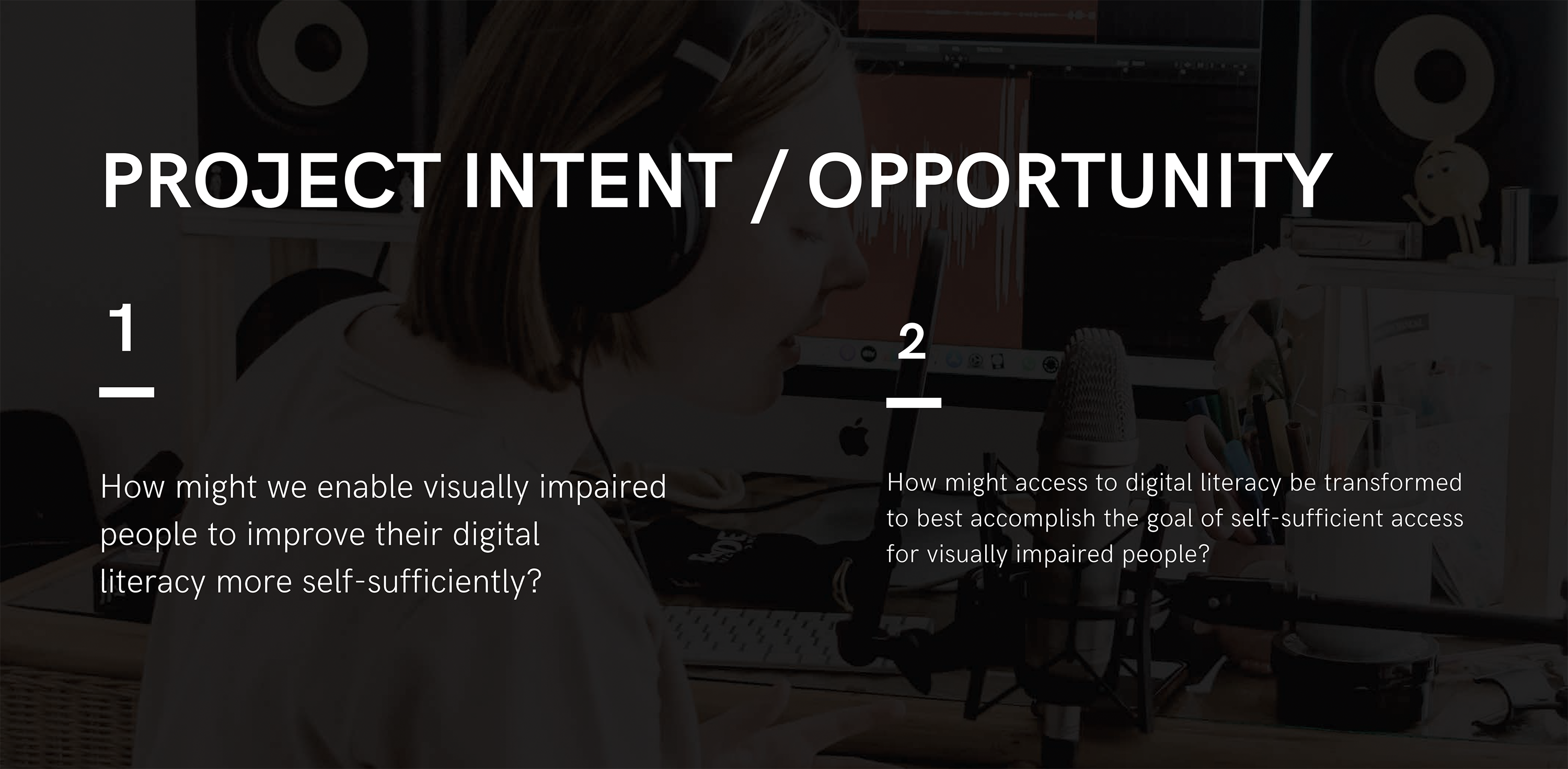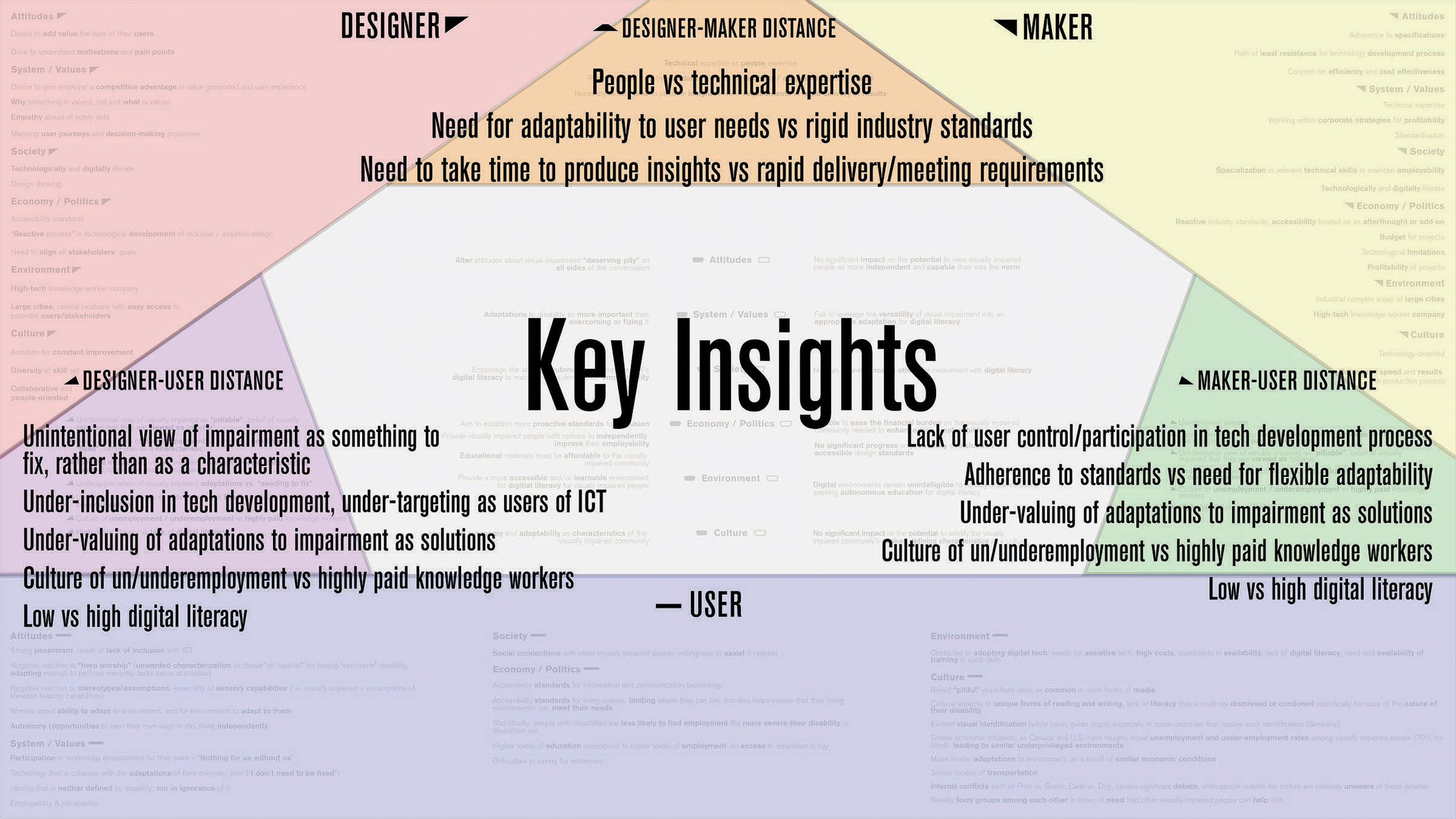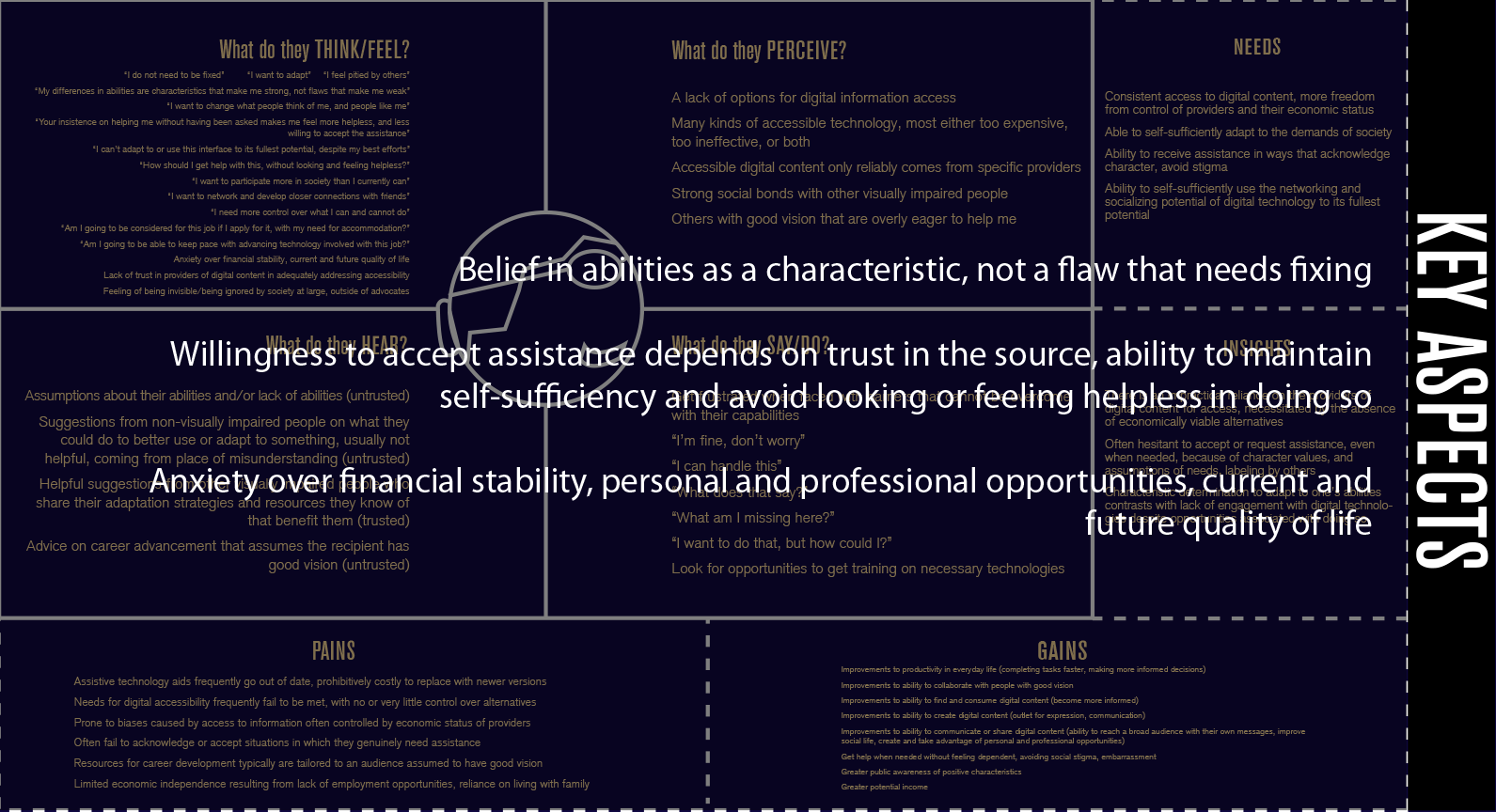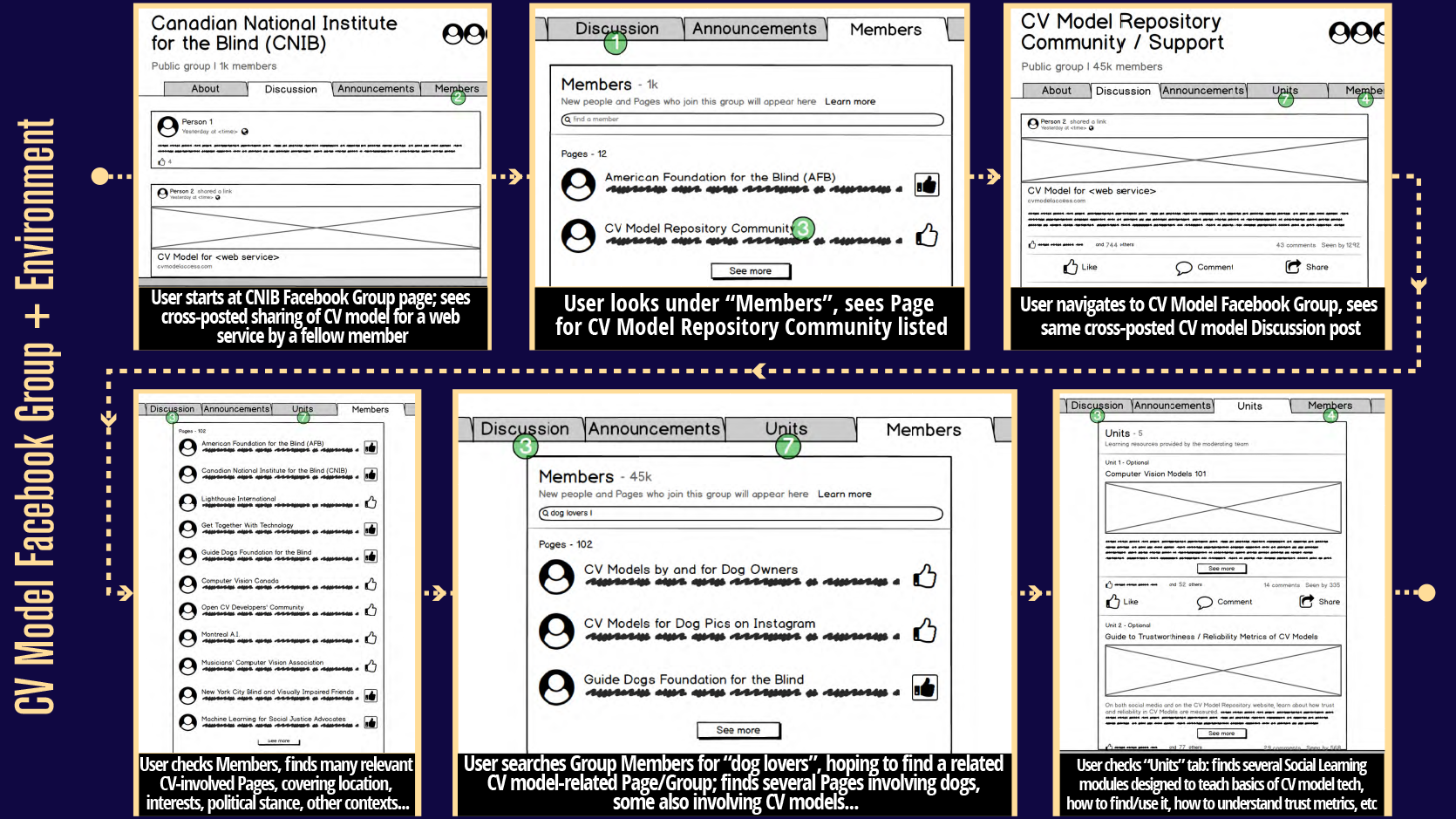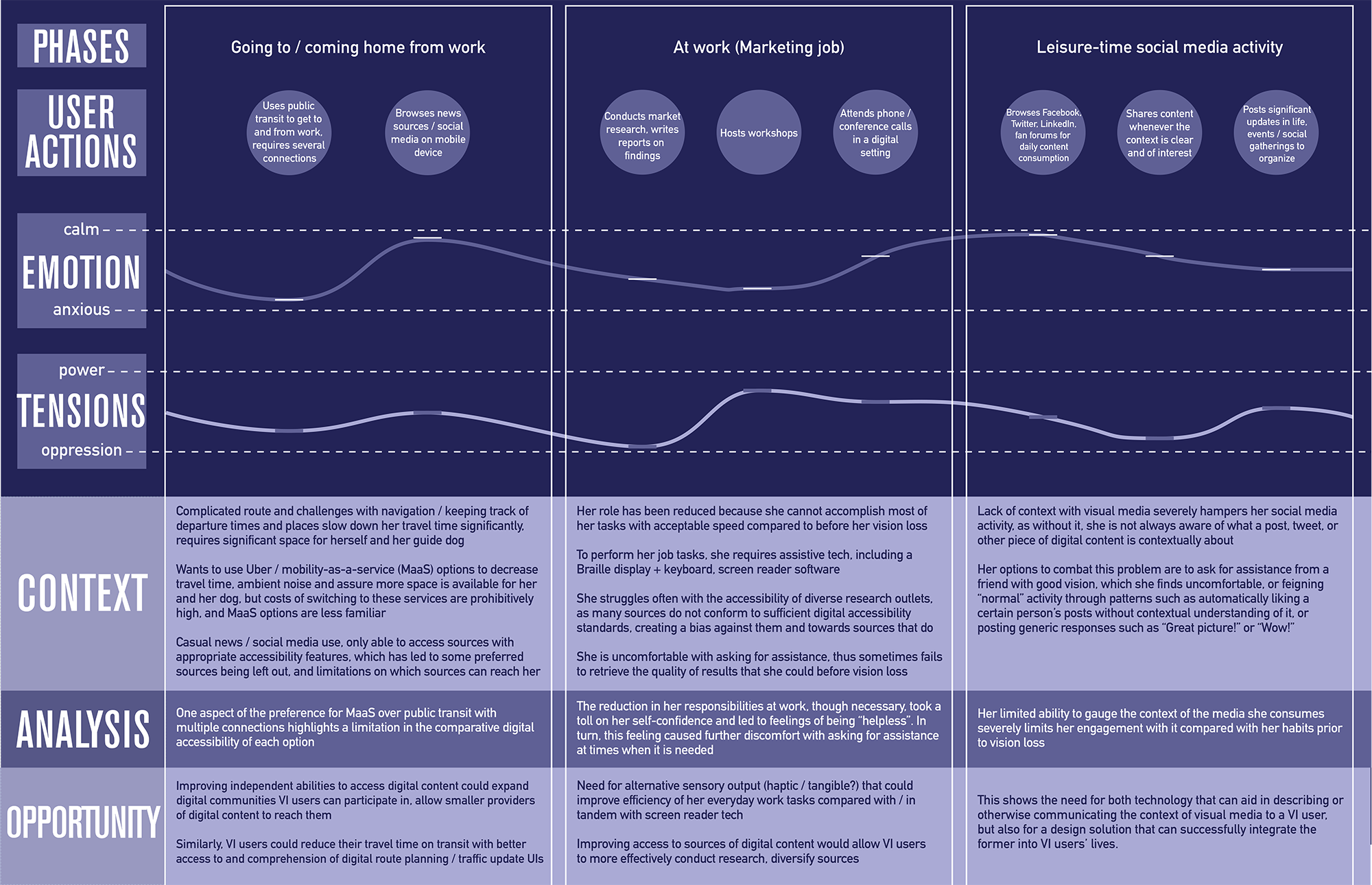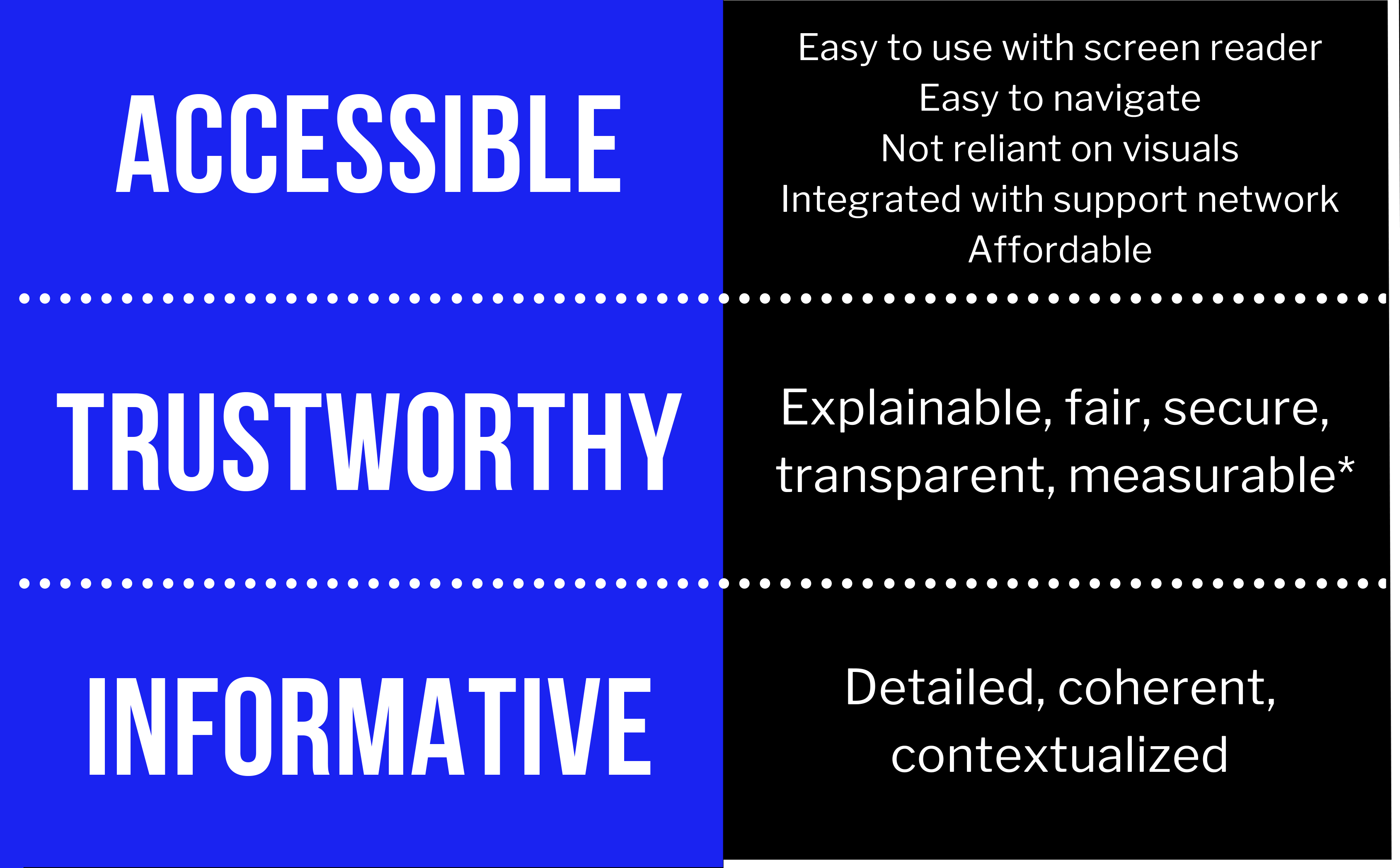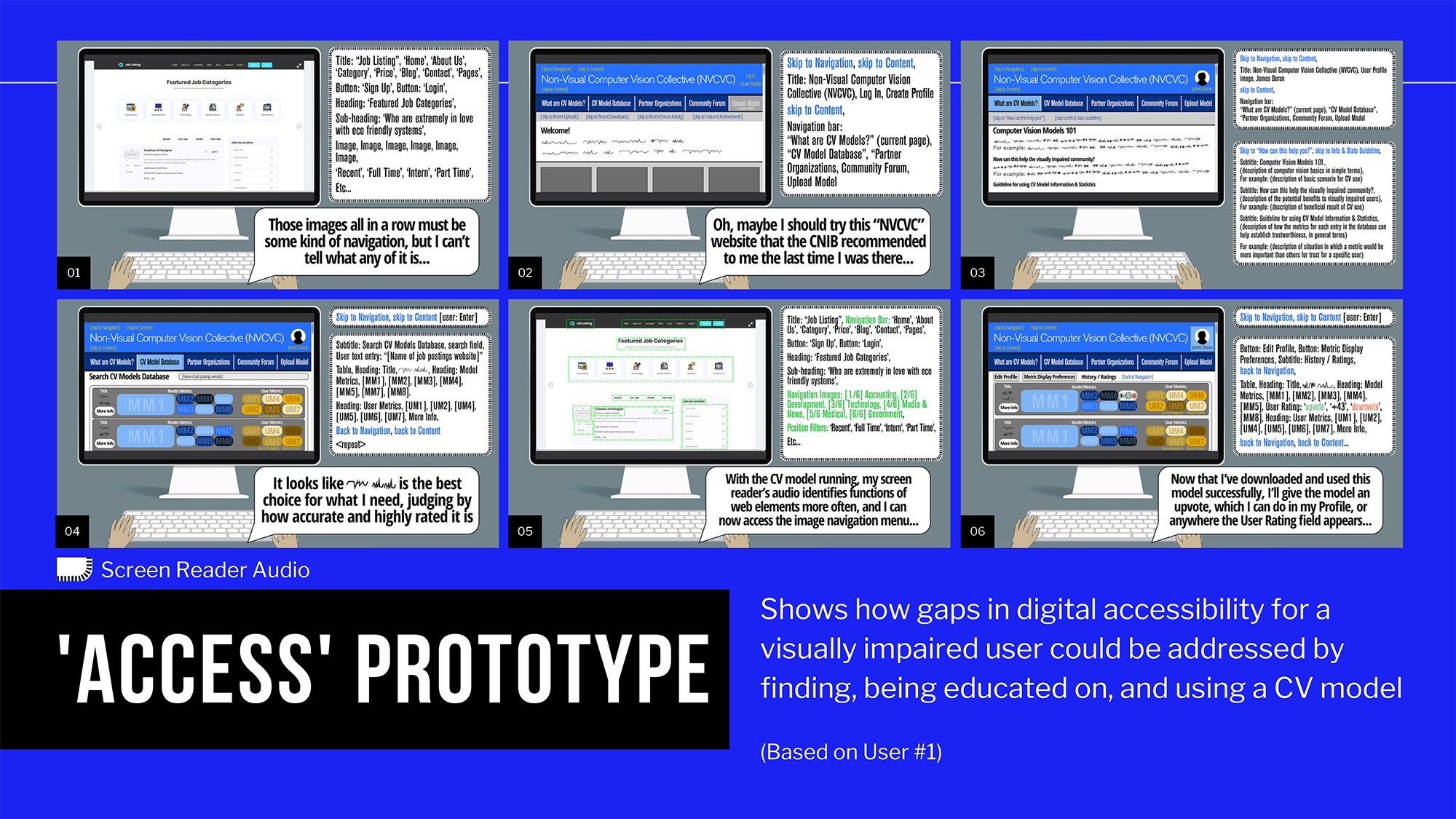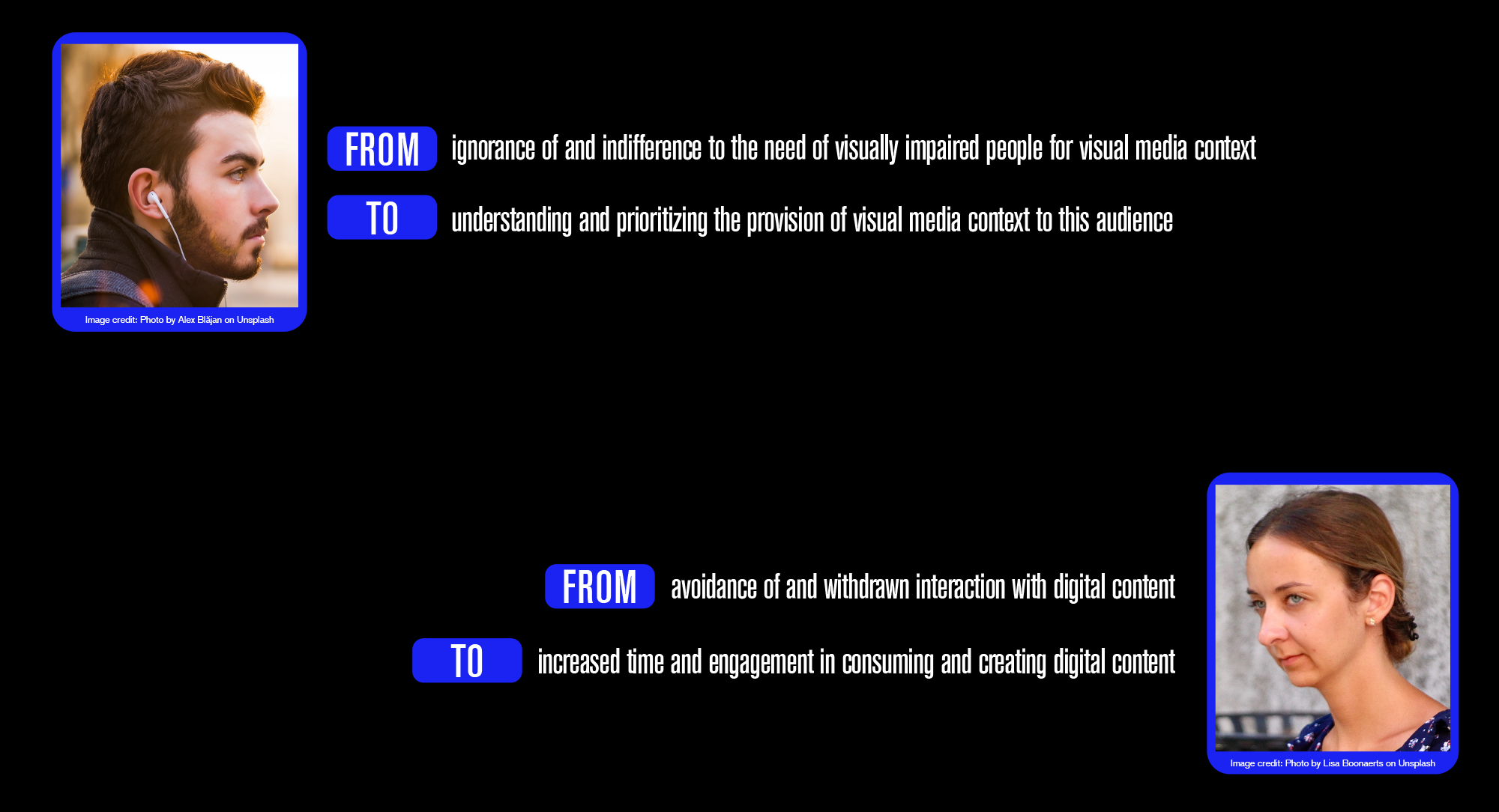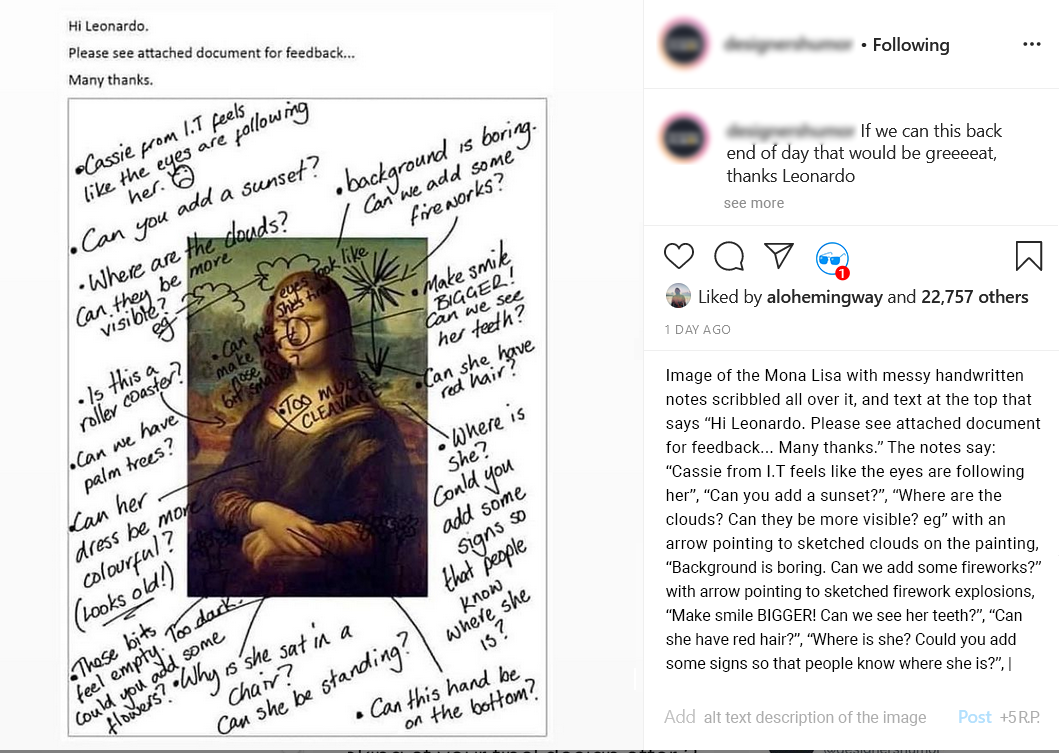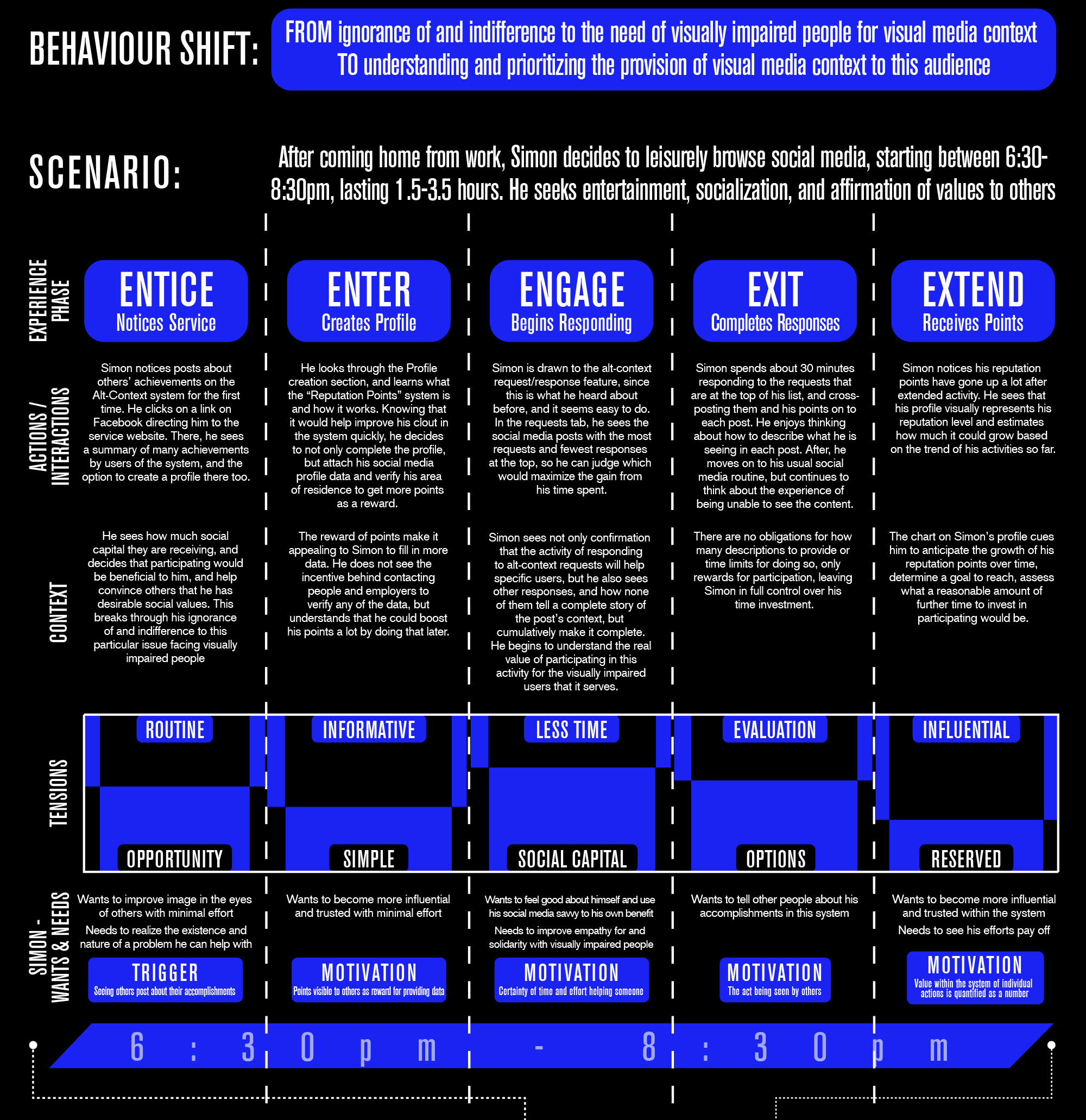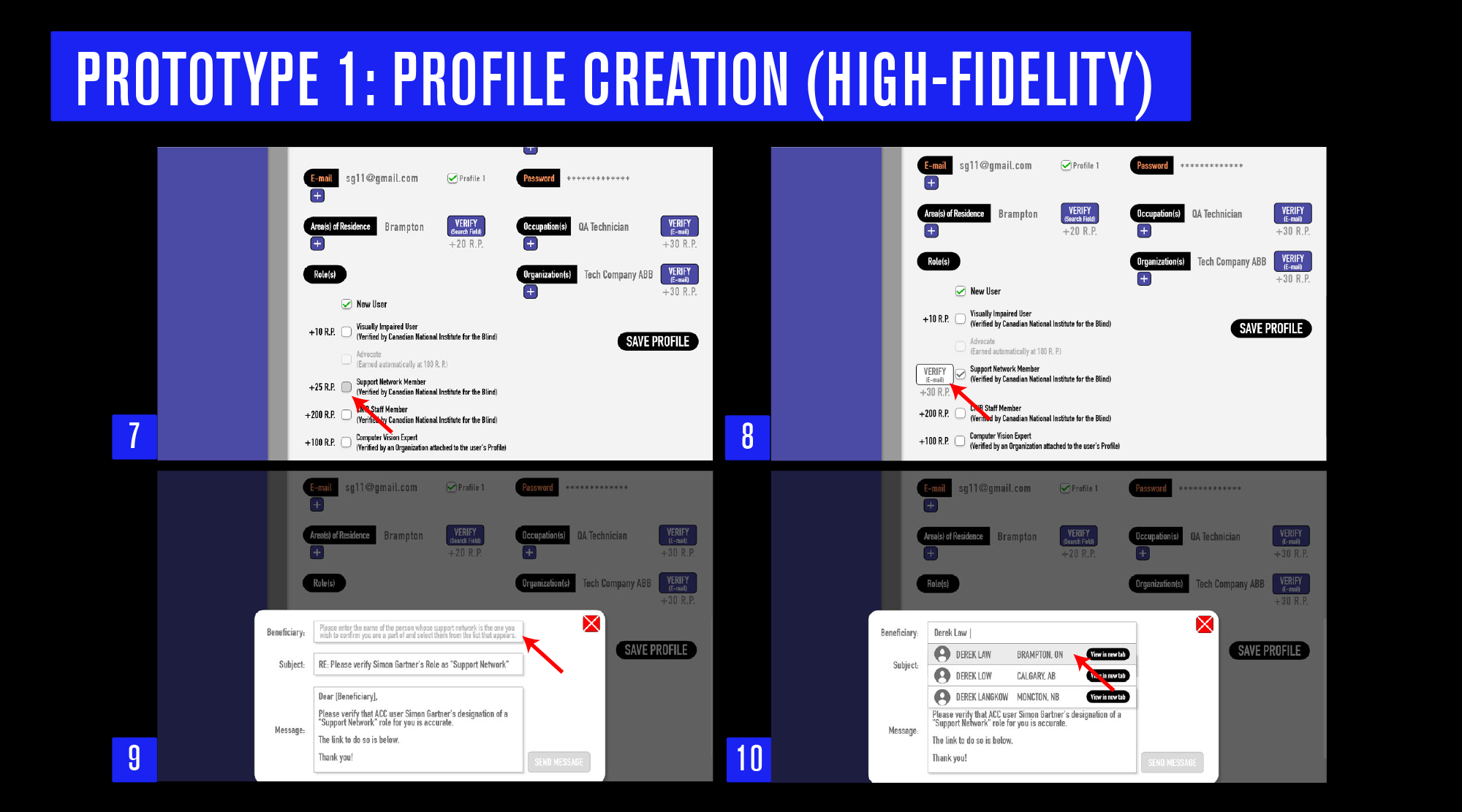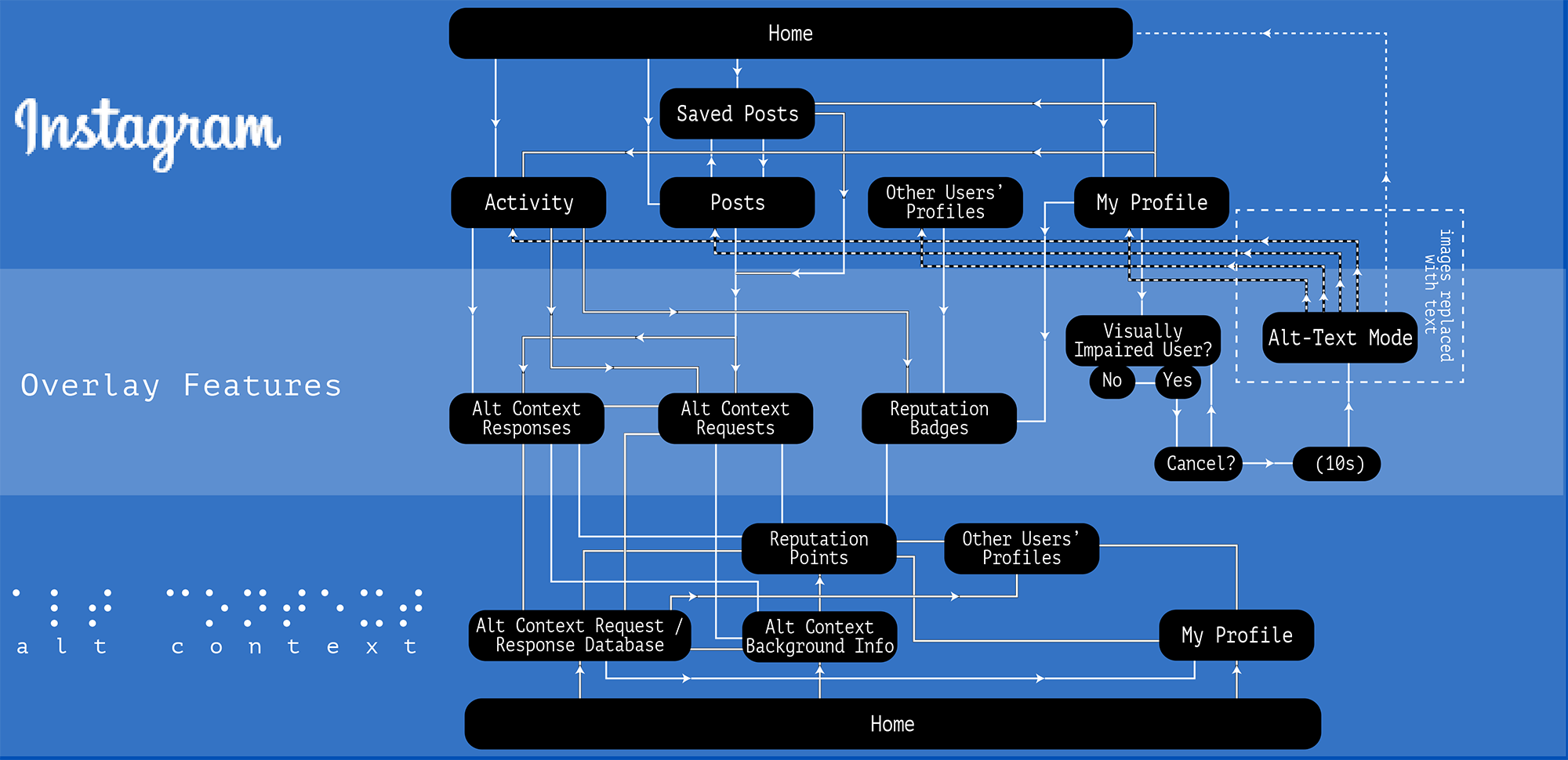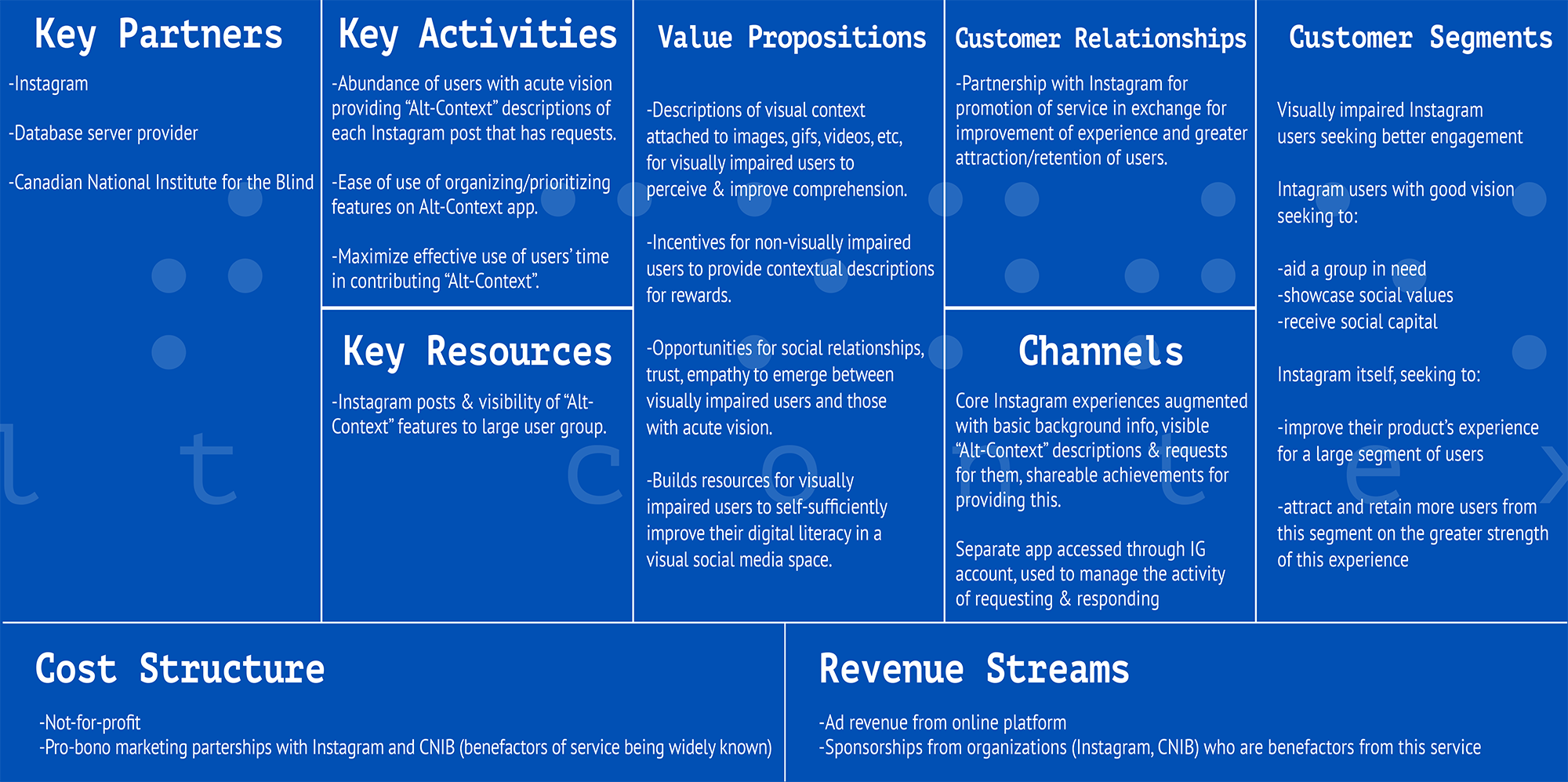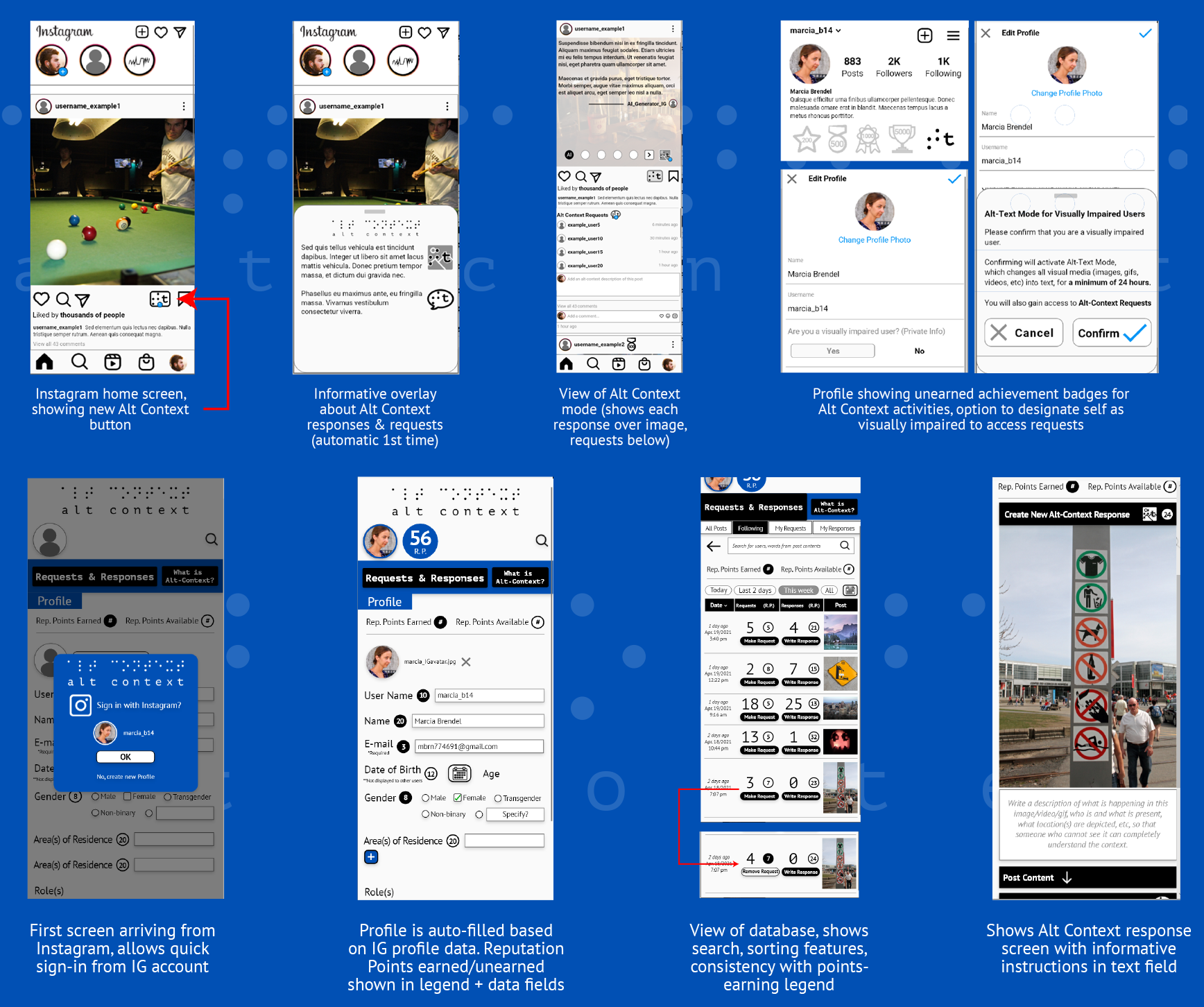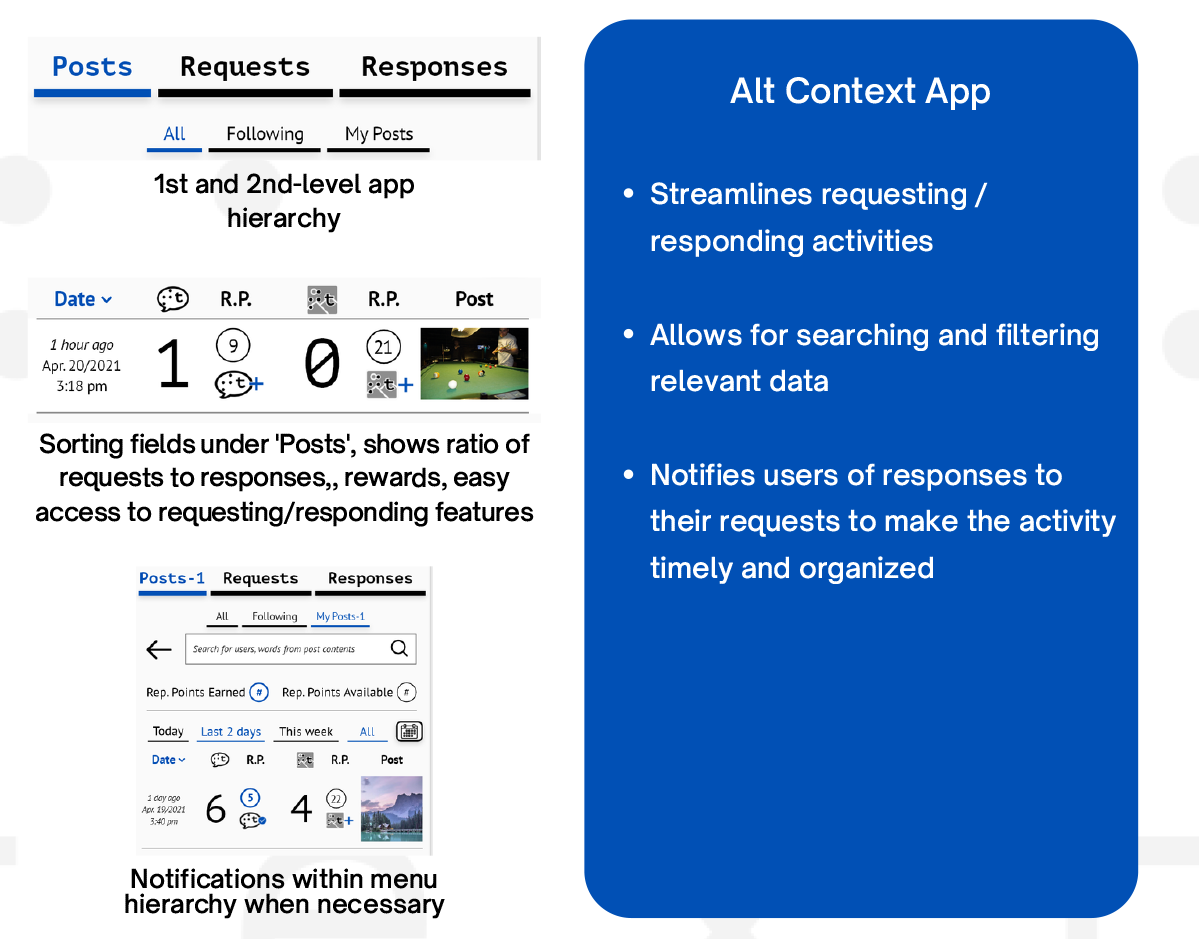Alt Context
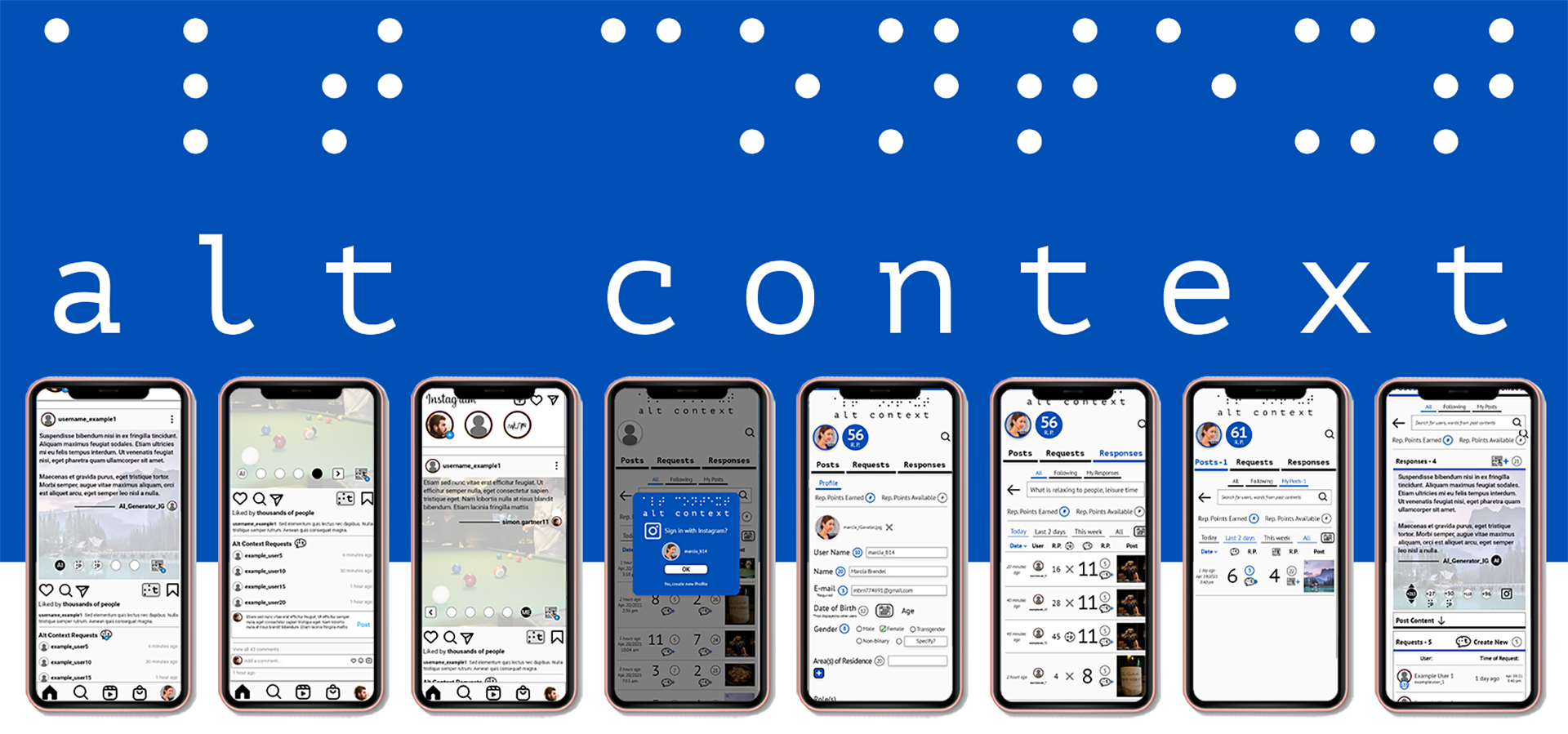
A service integrated with Instagram aimed at providing visually impaired users with self-sufficient access to comprehension of the visual context of media in posts.
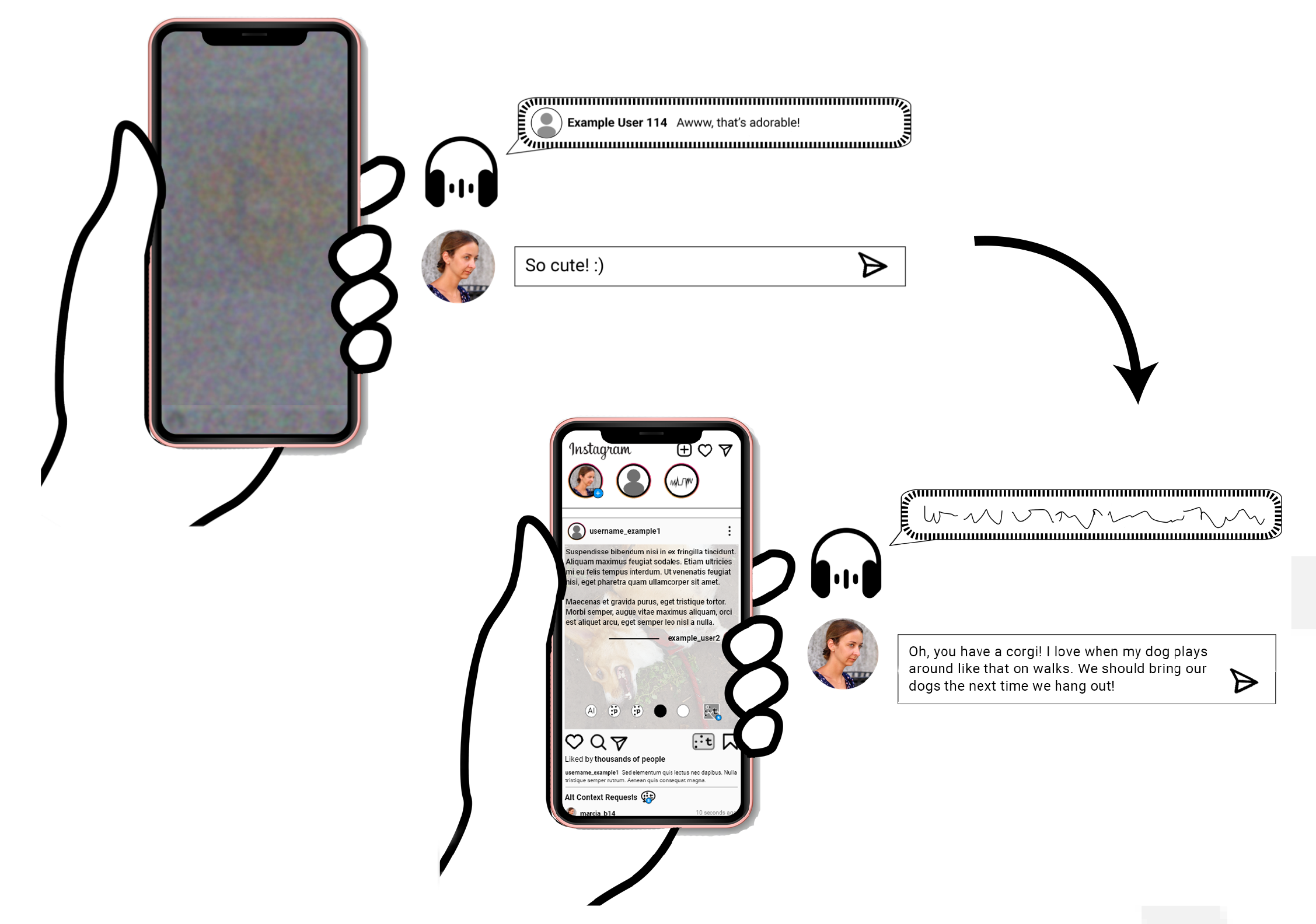
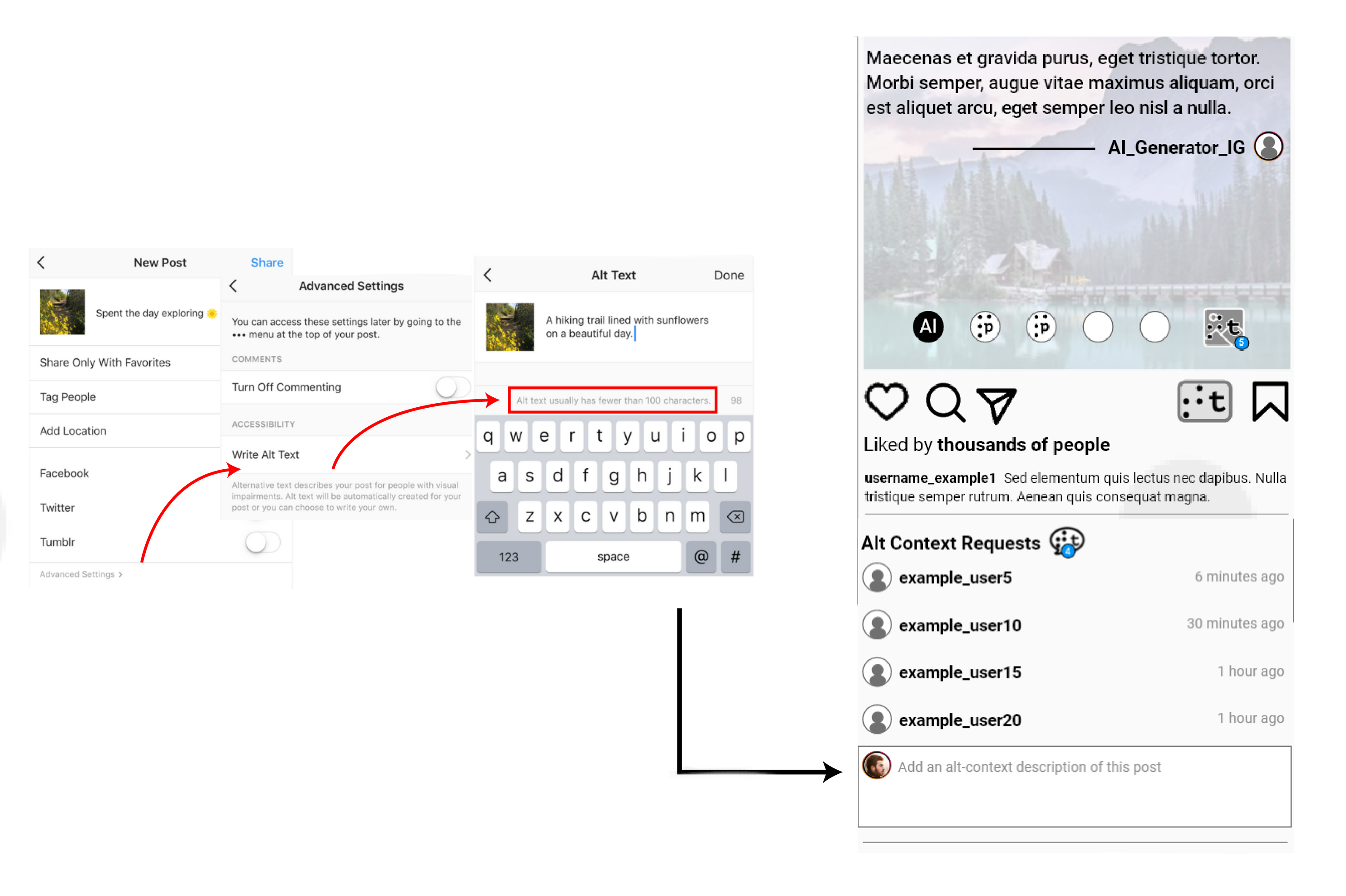
Alt Context is an approach to bridging this gap by crowdsourcing descriptions of the context of individual instances of visual media and providing these descriptions to visually impaired users in a similar manner as alt-text, readable through screen readers. Situated initially on the Instagram platform, it provides visibility for the need for descriptions of visual context to all users through a feature with which visually impaired users can request these descriptions for individual posts, and all other users can see these requests and potentially provide a response.
Design Process
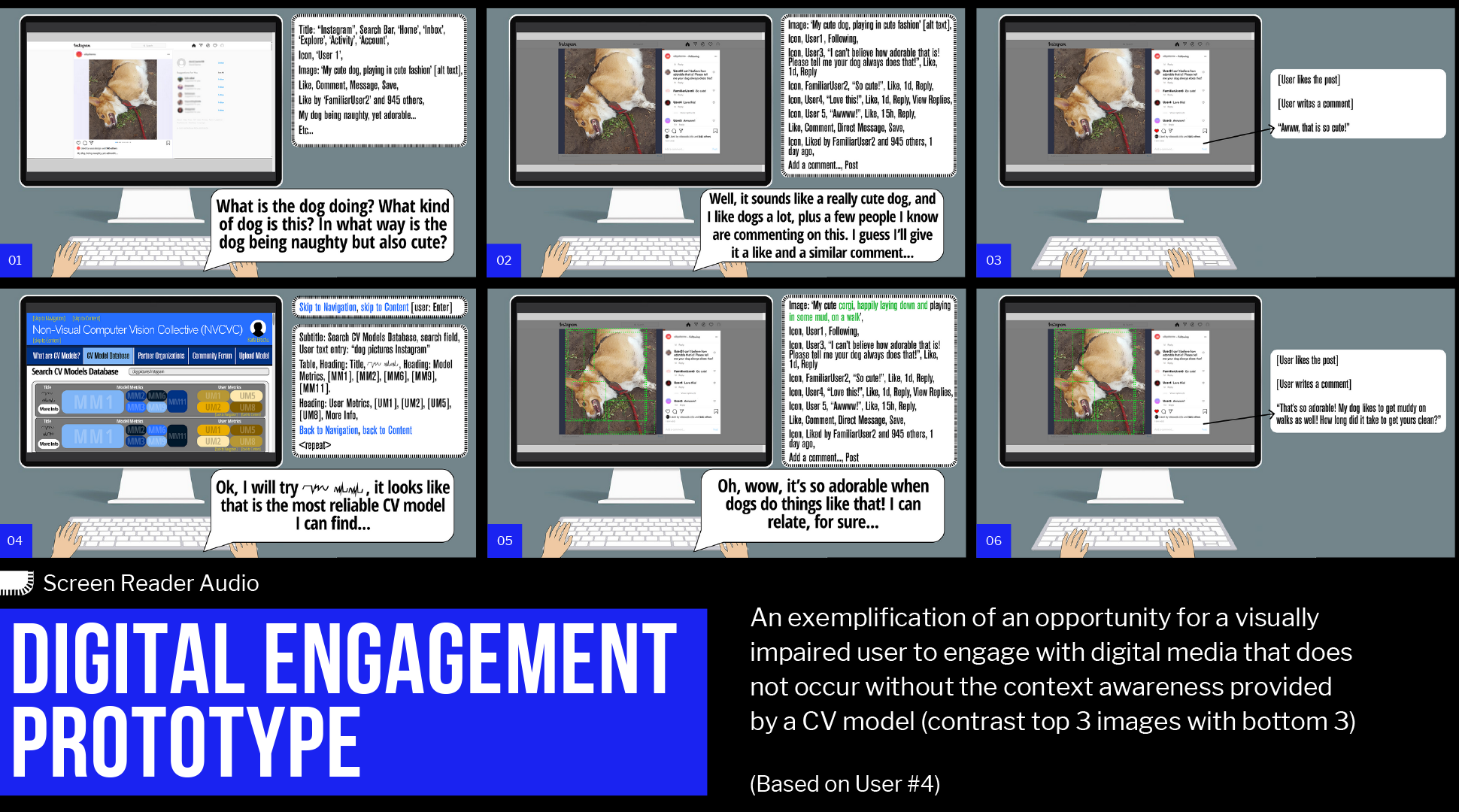
I first identified five areas of interest and did a preliminary STEEP-V scan for trends, signals (indicators of potential trends that have not yet materialized), and major issues that could reveal design opportunities, within these areas of interest. It was also expected that we relate these areas to one another and find hidden opportunities through these relationships
Focusing on research, I discovered several sources touching on the need for digital literacy, what this term means, its importance for people of differing abilities, and how challenges in this area affect many other crucial aspects of life, including employability, financial independence and socialization. For the visually impaired community, the challenges are most often directly related to differing abilities, so I saw an opportunity to change this cyclical issue.
Next phase of research – the key insights here are not only from defining the norms of who is the Designer, Maker and User in my proposal, but what “distance” (differences that cause conflicts/harmful power dynamics) exists between them.
Our value proposition was then defined by the term “augmented-physical learning”, suggesting the potential value to be gained by designing a system to deliver physical stimuli remotely and virtually. The major gains we identified were the ability to regain muscle memory (supported by our research) and improve recovery time and effectiveness, the immersiveness of the experiences we could create, and help people spend less time with their lives interrupted by injury recovery.
To pitch to Myant, our project proposal focused more explicitly on the users of our proposed product: we built on our persona (based on a real professional race car driver who was injured and went through extensive rehab) and provided a look at an intended user journey that would provide value to someone in similar circumstances. Beyond this, we developed a clear breakdown of costs, competition in the market that we would face, an initiation strategy with specific phases identified, and a systemic view of how the product’s ecosystem would function, with all of the necessary partnerships with other companies and research institutions.
As part of the course’s speculative design methodology, a contextual speculative artifact is a conceptual product, service or system that exists and takes a form as a result of how the main speculative design concept has changed the world it exists in. For my concept, I imagined and
wireframed a Facebook Group architecture that unites several communities around the creation of computer vision models, educating the relevant audiences on them, promoting the need to contribute, and pinning down some trust dynamics for the community based on how existing groups on social media promote themselves and establish trust in others.
wireframed a Facebook Group architecture that unites several communities around the creation of computer vision models, educating the relevant audiences on them, promoting the need to contribute, and pinning down some trust dynamics for the community based on how existing groups on social media promote themselves and establish trust in others.
Through fully fleshing out a user journey map and coupling this with further user research, I identified the need among visually impaired users for “context awareness” of visual media; in short, users are unable to understand the full context of images and videos without being able to see them, and this causes behaviours such as aversion of visual-heavy digital platforms, and imitation of others’ behaviours who can see the media, which limits their engagement potential, but is appealing due to the feeling of having participated in social activity.
To evaluate and refine our concept, we introduced design criteria in the form of principles (2-3 rules that the project has to follow to achieve its intentions), values (definitions extrapolated from principles, i.e. “Informative” –> “Contextualized”), tensions (opposing qualities that the project could take on, and what level of balance between them would be right for the project to succeed), and intended changes from the project’s impact (”From [x] to [y]”)
Concluded the first semester of the project with refinements to my design intentions & criteria, empathy mapping, user journeys, and scenarios driven by a contextual speculative artifact. I then entered the realm of digital prototyping, focusing on one key aspect related to my criteria for each prototype I created: an “Access” prototypes, a “Trust” prototype, and a “Digital Engagement” prototype.
Behaviour exists at the intersection between a person’s mind and body, but observable to the outside world. Defining how my envisioned users’ behaviours would shift as a result of the existence of my project was a logical next step in evolving its design intention. I went through
numerous iterations of defining this shift as changes in actions and opinions for my non-visually impaired user, once they become more informed and empathetic towards visually impaired people, and changes in abilities and engagement potential with technologies and people for my visually impaired user.
numerous iterations of defining this shift as changes in actions and opinions for my non-visually impaired user, once they become more informed and empathetic towards visually impaired people, and changes in abilities and engagement potential with technologies and people for my visually impaired user.
Further prototyping led me to introducing the concept of simply crowdsourcing the CV models’ output in the form of “alt-text” descriptions, as well as trust-driven features such as a “buddy” system for providing this content from one user to another.
I defined and developed personas based on my empathy maps of “User #3” (ill-informed advocate) and “User #4” (social media power user with recent 90% vision loss), in order to clearly visualize who they are and what they need before developing a micro user journey map that
takes them both through a timeline of activities in which they encounter and use my product. It focuses on the “5 E’s” (Entice, Enter, Engage, Exit, Extend), and since their scenarios are intertwined, I decided to map both journeys on the same timeline, just at different points, which
visualizes the minute interactions between them and the product very well.
takes them both through a timeline of activities in which they encounter and use my product. It focuses on the “5 E’s” (Entice, Enter, Engage, Exit, Extend), and since their scenarios are intertwined, I decided to map both journeys on the same timeline, just at different points, which
visualizes the minute interactions between them and the product very well.
Refined my behaviour shifts, design criteria and micro user journey. The main focus was developing three prototypes of different levels of fidelity. My hi-fidelity prototype demonstrated the profile creation process for the app concept (balance between too much personal data vs. not enough to foster trust between users), while the medium-fidelity prototype was of my envisioned computer vision model requesting component, which was still a part of the project as a scalable option after using the “Alt Context” features of the product, and finally, the low-fidelity prototype was a run through of using the app to filter for Alt-Context requests and responses, manage them, and to participate in the activity of receiving or producing Alt-Context.
Gate 5 was meant to finalize most of the conceptual elements of the project, its target market, features, interactions, impact, how it functions as a system, and more. I decided to fully de-emphasize the computer vision model platform into a scalable future element that could come
into play once users interacting with the Alt Context features (initially on Instagram, but also scalable to other platforms later) and through this learn about what the outcomes of a computer vision model for digital accessibility for visually impaired people would look like down the road. So, when producing a system map, I only included core Instagram features, core features of my Alt Context app, and overlay features on Instagram powered by the Alt Context app that would reach the largest possible audience.
into play once users interacting with the Alt Context features (initially on Instagram, but also scalable to other platforms later) and through this learn about what the outcomes of a computer vision model for digital accessibility for visually impaired people would look like down the road. So, when producing a system map, I only included core Instagram features, core features of my Alt Context app, and overlay features on Instagram powered by the Alt Context app that would reach the largest possible audience.
Instagram stands out as an especially visuals-oriented digital platform, so it was the logical choice to focus on. The value proposition for Instagram is thus tied to attracting and retaining a large segment of the population (visually impaired people) that previously could only make use of the platform in a very limited way, while for the users, the resources for self-sufficient digital literacy and social engagement on Instagram would be highly transformative.
For my brand, I started with the idea of using Braille as a visual element, even though it is meant to be tactile, because its visual form, to people who have vision, clearly indicates “something to do with visually impaired people”, so it helps show who my product is meant to serve. I tried many variations of the words “Alt-Context” represented in Braille and created logos for major features such as requests and responses using simple affordances that indicate their function, such as layering the Braille-t icon over an image icon for responses (which appear as overlays on top of the images).
The final prototypes I delivered for Gate 5 used some of the visual elements of those from Gate 4, but having developed a brand identity for an app, the style changed substantially towards that end. I focused on demonstrating the new features on Instagram, how it connects to the app, why and how the app should be used, and what it looks like from my two users’ perspectives. I also developed a short scenario movie that focused on who the users are, and what impact using the app would have for each of them.
My final deliverables for Gate 6 were all about refining the project as much as possible. Mainly, I updated the branding and how it was being used in the prototypes to conform the look of the project more to Instagram’s visual aesthetic, while still standing out as its own brand. I did this by making the menus and headings, as well as the icons, much less heavy, and much simpler. It was still a challenge to sufficiently minimize the information design of the app screens – this remains a work in progress. Finally, my scenario movie for this final deliverable was updated to better communicate the behaviour shifts more so than only the impact that using the product would have on its users. The audience needed to see some degree of what using Instagram (for visually impaired users) and being unfamiliar with the visually impaired community’s needs (for non-visually impaired users) looked like without Alt Context, as well as how Alt Context could change that.
Results
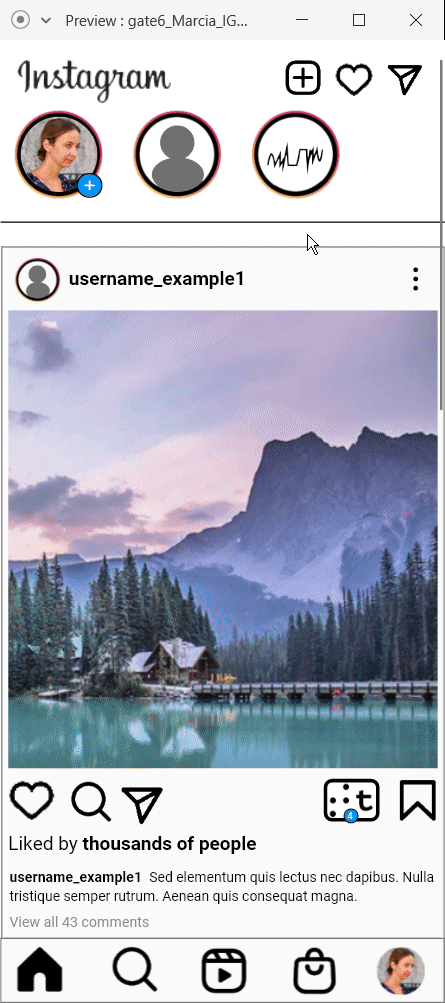
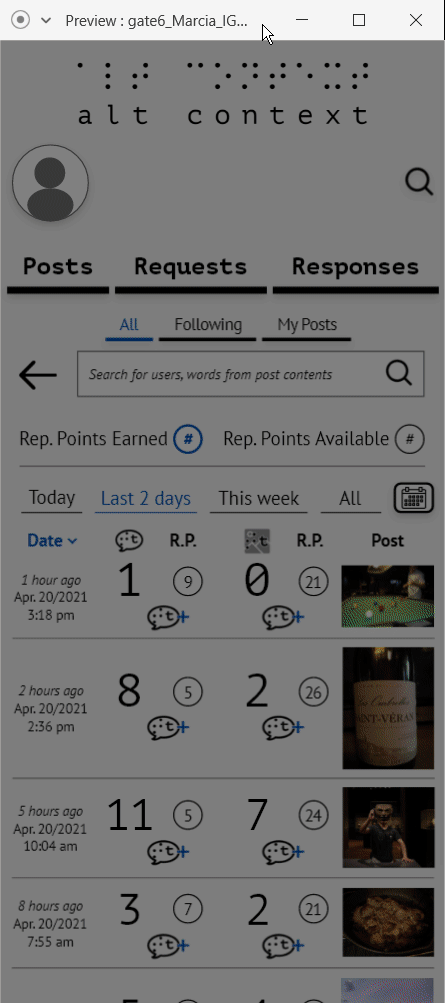
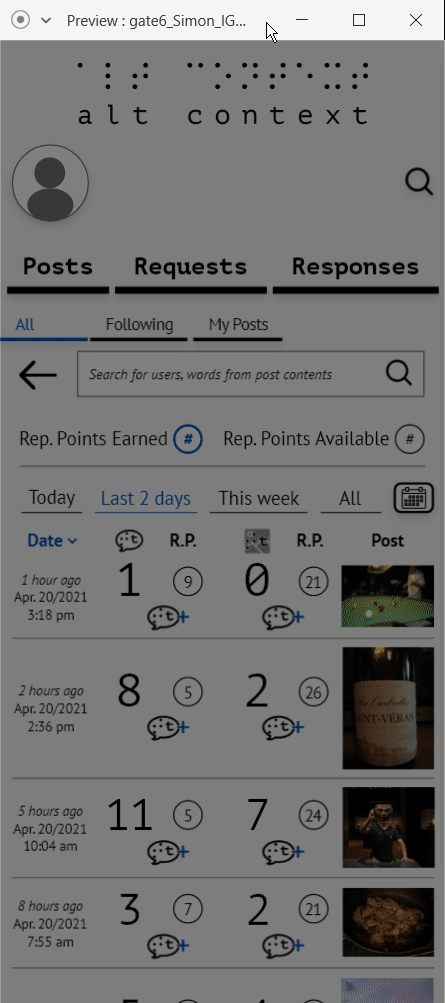
- OCAD University Industrial Desgin Undergraduate Thesis
- September 2020-May 2021

